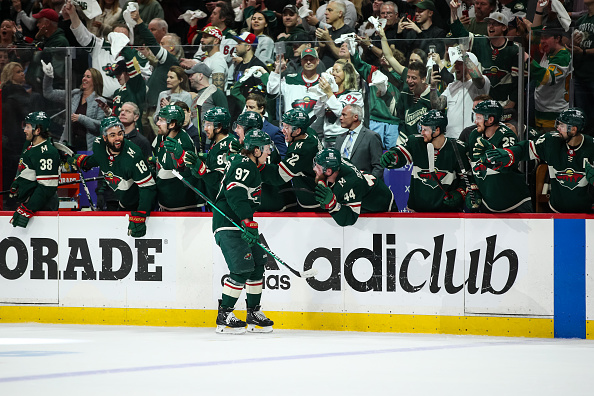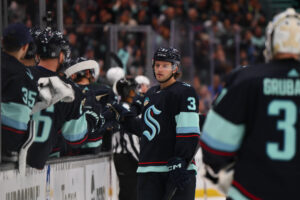,=Last Word on Hockey’s Puck Drop Previews are back for the 2022-23 season! As the regular season approaches, Last Word will preview each team’s current outlook and stories to watch for the upcoming year. We’ll also do our best to project how things will go for each team over the course of the campaign. Today, we’re previewing the 2022-23 Minnesota Wild.
2022-23 Minnesota Wild
Note: All analytics provided are from Evolving-Hockey.
2021-22 Season
Minnesota had their most successful regular season in franchise season in 2021-22. The Wild finished last season with a record of 53-22-7 (113 points), finishing second in both the Central Division and the Western Conference. Minnesota’s 53 wins and 113 points were both franchise records.
Minnesota had an underrated and suffocating defense backing historic offensive performances from Kaprizov and company. Goaltending was a small, looming issue throughout the season: one that was solved through untraditional means for a playoff contender such as the Wild. A great season capped by a very unfortunate and underwhelming finish, losing in six games to the St. Louis Blues.
Kirill and the Offense
Minnesota had their best offensive season to date, led by the mastermind of Kirill Kaprizov, alongside Mats Zuccarello, Kevin Fiala, Ryan Hartman, and others. Despite finishing 19th in xGF/60 team-wide, the Wild were second in GF/60. The Wild displayed a highly efficient mode of offensive creation, through the means of middle-lane openings and elite shooting across the board.
Suffocating Defense
An underrated aspect of the Wild in 2022 was their team defence. They didn’t necessarily possess the best defensive core. However, they received stellar to incredible play from their top three defenders (Brodin, Spurgeon, and Dumba), compounded by the incredible defensive masterclass of the Marcus Foligno line (with Eriksson Ek and Greenway alongside Foligno) displayed throughout the entirety of the season. For reference, the Wild finished only behind the Boston Bruins in xGA/60 league-wide in 2021-22.
Inconsistent Goaltending
The Wild started the year with Cam Talbot and Kaapo Kahkonen as their tandem. By the end, it was Marc-Andre Fleury pushing aside Talbot to the backup position, with Kahkonen out entirely. Both Talbot and Kahkonen were flipped around by Minnesota management, with their struggling play becoming more apparent by the trade deadline. Fleury, despite his own struggles, still appeared as a more reliable option who would more likely be stable within the Wild system.
2022 Offseason
Loss of Fiala
The largest story of the Minnesota Wild offseason (perhaps aside from the Kaprizov in Russia saga) was the trade of Kevin Fiala. Fiala provided incredible playdriving in more dynamic formats between 2019-20 and 2021-22. Fiala’s struggle with Evason and the staff of the Wild was well documented. The move was being hinted at more and more by the draft. Eventually, a deal was settled with the LA Kings. While the Wild surprisingly received little in quantity, they got a very high-quality college defensive prospect in Brock Faber and the 19th overall pick within the 2022 draft, eventually selecting Liam Ohgren.
Other Offseason Moves
Minnesota brought aside some depth within Steven Fogarty, Nic Petan, and Andrej Sustr on small-league deals. The largest addition this offseason came in signing Sam Steel, an Anaheim-grown prospect who has not quite developed in the fashion hoped. Minnesota also swapped Talbot in favor of a younger goaltending prospective in Filip Gustavsson. The largest subtraction aside from Fiala was the Kulikov trade for future considerations to Anaheim. Kulikov was a surprisingly effective bottom-pairing defender whose departure may have more of an impact on the Wild d-core than many may think.
Lineup Projections
Forwards
Kirill Kaprizov-Ryan Hartman-Mats Zuccarello
Marcus Foligno-Joel Eriksson-Ek–Jordan Greenway
Matt Boldy–Marco Rossi-Sam Steel
Tyson Jost-Frederick Gaudreau–Brandon Duhaime
Top Six
Minnesota possesses one of the best top six groups within the NHL (despite the loss of offensive dynamo, Fiala). Kaprizov, Hartman, and Zuccarello played a highly effective and octane puck-moving game; the dynamic presence of Kaprizov, the playmaking of Zuccarello, and the finishing ability of Hartman (who is not a typical first-line center by any means) culminated in an incredibly efficient offensively driving force, scoring at a pace above four goals per 60.
Eriksson Ek, often ranking among the league’s best two-way centres, is slotted at center alongside fellow forechecking menaces in Foligno and Greenway, forming an effective physical and suffocating two-way second line. For reference, this line ranked fifth among all forward lines in the league in xGF%, with an elite mark of 60.85% (minimum 300 minutes played). The top six for Minnesota show no indication of concern for their future play.
Bottom Six
Considering the loss of Fiala, Minnesota’s bottom six is most likely weakened. However, the youthful talent of the group may provide a new sense of energy and depth to the Wild lineup. Matt Boldy emerged on the scene last season, living up to some of the hype attached to his game as a prospect within the system. 2020 9th overall pick Marco Rossi fought off his struggles with COVID and was a top producer on the Iowa Wild in the AHL (leader in assists and points). Steel on the right of the aforementioned Rossi and Boldy could provide a high-speed transition force who could fill in for the absence of Fiala as a whole.
Minnesota’s fourth line features Frederick Gaudreau, an effective bottom-six playdriving forward, centering Connor Dewar and Brandon Duhaime. Jost and Duhaime are more typical bottom-six checking forwards (albeit Jost is higher-end offensively). Jost’s presence on the forecheck combined with the transition ability of Duhaime and Gaudreau may allow the line to apply some pressure and control the general pace of the play against lower-quality competition. With the right deployment, Minnesota’s bottom six could give the Wild more true lineup stability.
Defensemen
Jacob Middleton–Jared Spurgeon
Top Four
Surprisingly, despite employing two top 20-25 defenders, the Wild have some questions in their defensive core. Brodin is an excellent D-zone presence (one often underrated by fan bases across the NHL), while Spurgeon is one of the league’s premier two-way defenders. However, the players paired with these players bring some concerns alongside them. Dumba dealt with his inconsistent stretches throughout the past two seasons, while Middleton, a deadline acquisition from San Jose, is a more bottom pair/seventh defender quality of player who struggled with increased minutes given to him by the Wild to end last season.
For Dumba, a more consistent performance could allow him to achieve the results he had in previous seasons. Dumba’s transition game on both ends still allowed him to be semi-valuable, but he truly lacked the offensive generation he possessed in years past. For Middleton, perhaps a better adjustment to the Wild system could allow him to better increase his effectiveness; perhaps, this could come with a lineup demotion.
Bottom Pair
Exciting youngster Addison takes the left side with Goligoski. The latter has generally been a more effective middle-pair offensive defender. He is one who could create chances from efficient back-end puck movement and transition creation. However, as he has aged, his mobility has decreased, limiting his activation within the offensive zone. Despite this, Goligoski has found some effectiveness in a less-dimensional third-pair setting for the Wild. Addison comes into what will likely be his first season as a true NHL regular. His promising puck handling and play creation abilities from the backend. Perhaps Addison’s inclusion in the lineup could allow Goligoski to stabilize in a less mobile (but still intelligent) version of his game.
Goaltenders
Marc-Andre Fleury
Fleury followed up a Vezina-winning campaign with a rather subpar performance with the Blackhawks. After being brought to Minnesota via a trade deadline move, Fleury saw improvements with a more structured team in front of him. Minnesota showed their commitment to Fleury by awarding him a two-year deal headed into his age 38 season. Legitimate concerns could exist with Fleury’s play approaching 40. The goal for Minnesota is to give him more support in the front. Hopefully decreasing the workload he faces on a game-to-game basis.
Gustavsson, acquired in the offseason from Ottawa, is a promising young goaltender. He may play the role of a starter later on within his tenure with the Wild. Gustavsson provides some versatility to the Wild managing group. He can help to manage Fleury’s workload. He’s already shown some promise in the past in Ottawa. It’s furthering can provide the Wild with short-term and long-term benefits, as well as stability within the position.
Players to Watch
Matt Boldy
Boldy burst onto the scene almost immediately after his call-up last season. In the first 47 games of his career, Boldy produced 39 points (15 goals). His play caught the eyes of the entire league at times. His powerful shot, combined with smooth transition play and excellent offensive instinct, make him a captivating player for fans both in and outside of Minnesota. Boldy is one of the largest and most promising breakout candidates for the 2022-23 NHL season.
Calen Addison
Just like Boldy, Addison has most likely secured his spot as a regular within the Wild lineup. A promising puck-moving defender, Addison has had the eyes of management and fans alike on him. Addison showed tons of promise within the AHL for Iowa. What Addison represents is a slight unknown who could have a huge impact on the Wild roster.
Prediction for 2022-23 Minnesota Wild
Despite losing one of the top offensive keys lase season, the 2022-23 Minnesota Wild still possess a deep and versatile lineup under the coach Dean Evason. Colorado will most likely finish number one in the division and conference again. However, there’s no reason Minnesota shouldn’t have a chance to snag the second spot within the division. No other team in the division significantly improved. It could be argued many worsened just like Minnesota (even at a worse rate). The 2022-23 Minnesota Wild will be easy playoff contenders, with some potential to even be secondary cup contenders.






